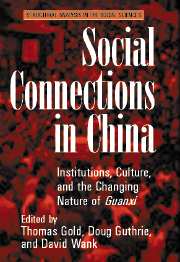Book contents
- Frontmatter
- Contents
- Contributors
- List of Figures and Tables
- Prologue
- Introduction
- Methodological and Conceptual Considerations
- 2 Information Asymmetries and the Problem of Perception: The Significance of Structural Position in Assessing the Importance of Guanxi in China
- 3 Beyond Dyadic Social Exchange: Guanxi and Third-Party Effects
- New Substantive Studies of Guanxi
- Conclusions
- References
- Index
3 - Beyond Dyadic Social Exchange: Guanxi and Third-Party Effects
Published online by Cambridge University Press: 30 July 2009
- Frontmatter
- Contents
- Contributors
- List of Figures and Tables
- Prologue
- Introduction
- Methodological and Conceptual Considerations
- 2 Information Asymmetries and the Problem of Perception: The Significance of Structural Position in Assessing the Importance of Guanxi in China
- 3 Beyond Dyadic Social Exchange: Guanxi and Third-Party Effects
- New Substantive Studies of Guanxi
- Conclusions
- References
- Index
Summary
Guanxi is one of the most noted phenomena in contemporary China. Three related issues figure prominently in the research on guanxi: its pervasiveness, the reasons for its pervasiveness, and its role in socioeconomic activities. This chapter attempts to take a further examination of the third issue. In particular, I explore the forces that shape the process and outcome of guanxi-mediated social exchange. My investigation is motivated by the fact that despite wide recognition of guanxi as the nexus of multilateral social networks, dyadic interaction remains the focus of analytic attention. Much has yet to be said about how the rules and results of an exchange between two parties connected through guanxi are affected by the interactions of either or both of them with other parties in their respective social networks. I call the effects of such interactions on dyadic social exchange “third-party effects.”
My analysis of this issue starts from two related views about an essential role that guanxi can play in socioeconomic activities – that is, facilitating the exchange of favors. Because of the varying degrees of expressive and normative considerations involved, guanxi-mediated favor exchange may have some advantages over pure market transaction. It may, for example, help contain risk and uncertainty, sustain cooperation, and provide a reciprocal lever for opportunities. According to a widely shared view (e.g., Bian 1997), the strength of the ties between the parties involved holds a key to understanding how and to what extent the role of guanxi in this regard is played out.
- Type
- Chapter
- Information
- Social Connections in ChinaInstitutions, Culture, and the Changing Nature of Guanxi, pp. 57 - 74Publisher: Cambridge University PressPrint publication year: 2002
- 13
- Cited by

